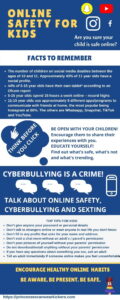Internet safety for kids should be a priority in every home! It’s so important to keep up-to-date with what’s happening online, but it’s also pretty overwhelming as there is so much information to wade through!
My hope is that with this blog I can highlight some of the main issues regarding internet safety for kids and help you understand how your child is using the internet and what you need to do to ensure their safety.
This simple infographic is easy to read, contains clear facts and figures and can be saved, printed or shared.
The only way we can beat cyberbullying, ensure our kids are using the internet safely and keep in touch is by understanding how the internet is used by the younger generation.
EDUCATE YOURSELF!
See what’s trending on games/apps for kids your child’s age. Get familiar with them. Once you have an understanding, you will be able to talk to your kids about them and more importantly, ensure they are not using programs that are inappropriate for their age. ALWAYS check privacy settings and recommended age restrictions. Some online games have the option to turn chat off. This is a great option for younger kids.
BE PRESENT
- Have regular conversations about online safety and usage – ask for your child’s opinion and thoughts on safety. That will give you a good idea on how aware they are.
- Encourage them when they share their online experiences
- Make sure they know they can always come to you if they’re upset about any online content
- Stay calm, don’t judge and LISTEN
DO THEY KNOW THE RULES?
- Don’t share personal information online
- Use a strong password
- Only talk to real-life friends or family online (especially on social media)
- People online might not be who they say they are – be aware!
- Be a good online friend
- Always (and only) use secure and legal sites to download music and games
- Check with a parent/guardian before downloading ANY online content
FOR YOU TO DO
- Ensure content lock is set on smartphones
- Set parental controls on home broadband
- Control download/app purchases
- Use safety mode on YouTube and Google
- Ensure privacy settings are at their highest on social media
TALK ABOUT
CYBERBULLYING
This is an issue I will be looking into in far more detail in a series of blogs. However it’s vital that you help your child understand the responsibility they have when sharing content online.
They need to BE SMART and BE KIND
Nothing ever goes away once it’s been posted online. It can’t simply be erased.
If they find themselves a target of cyberbullying they need to:
- Tell an adult.
- Keep messages as evidence and block the bullies.
- Know that you are there to help and support.
- Know that the bullying can be stopped.
Sexting – Have an open conversation about what can happen as a result of sexting. They may think they’re mature enough to have sex, but could they handle the repercussions when sexting goes wrong? Be frank, be honest and you will help your child understand the implications of sending nude images/videos.
If your child has sent a nude image that has been shared online, report it immediately to CEOP and Childline who can help get all known copies removed from the internet.
Think before you click
For more information on the latest internet safety for kids, click here where you will find more blogs as well as information on the latest online chat used.
Click to expand and download this infographic



Recent Comments